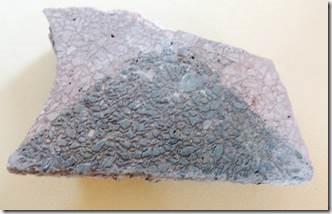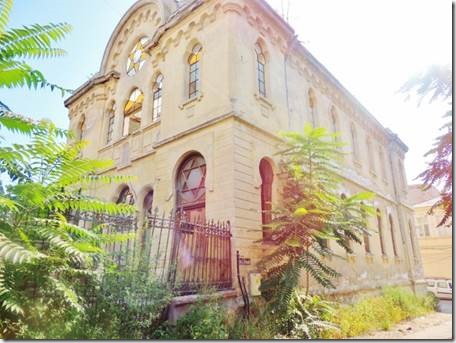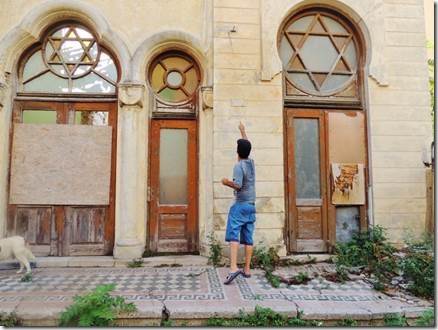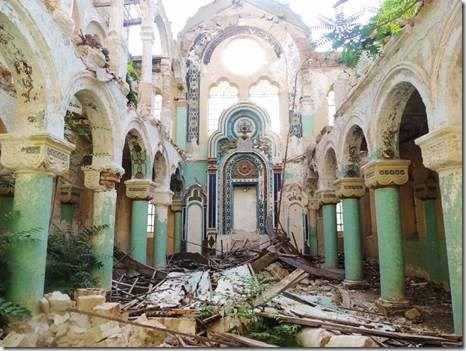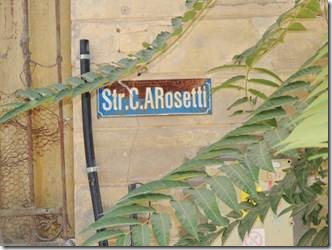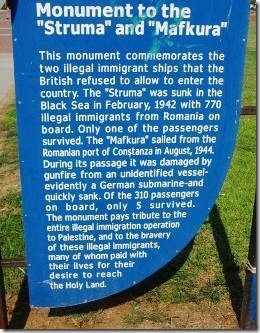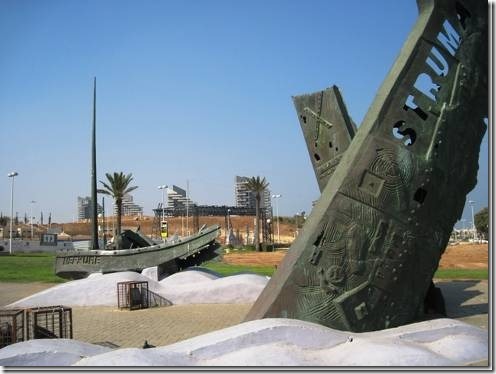Sozopol Marina
Sozopol, Bulgaria
добър ден dobŭr den Good Afternoon
We went off exploring old town Sozopol today and had a grand time. It’s small enough so you don’t need a map unless you’re looking for a very specific place and even then you hardly need it. I’ve taken lots of photos so you’ll see the place eventually. We’ll be here tomorrow too, so will explore the newer part of town which isn’t so much bigger than the old part of town. I like small.
This email is about the synagogue of Constanta; the connection with memorials in Israel, and some silliness about Romanian food.
Ru
|
Jewish Constanta There is a small chunk of the Great Synagogue of Constanta on DoraMac. I didn’t take it; it was given to me as a gift. We were out looking for a chandlery Rick vaguely remembered from 3 years ago when I saw a street and building that I believed to be the remains of the Great Synagogue. We walked over to C A Rosetti Street and found the building with a locked gate and barking dogs. A man from the house next door saw us and asked if we would like to visit the building. We said yes; he shushed the dogs, unlocked the gate and let us into the yard adjacent to the synagogue. |
|
“Currently, the only synagogue in Constanţa – the Great Synagogue, is in an advanced stage of degradation, being abandoned and ransacked, in a real danger of collapse. From the entire synagogue, there are only three full walls left, fractured diagonally. The roof was destroyed, so were the majority of colored glass windows. The walls still preserve intact Jewish symbol – Star of David. Although the entrance to the synagogue is not forbidden, even though the synagogue is in danger of collapse, the access is impossible because of the packs of dogs in front of it. On the left and right side of the building, there are new buildings; whose construction has only weakened the”skeleton” left standing. Only 16 years ago, during 1995-1996, the local residents said that religious services could be held in the synagogue. Once abandoned, without a security guard hired to watch it, the building was ransacked of anything that was not nailed down. “ http://anale-arhitectura.spiruharet.ro/ “The tenants of the neighboring house, who had put a chain to the gate and a few dogs in the yard, were the only ones to make sure and prevent homeless people take shelter inside the building.” http://anale-arhitectura.spiruharet.ro I gave the man a 10 Lei note to thank him. Then I bent down to pick up a small bit of concrete as a reminder. He then picked up a huge piece from the pile on the porch and broke a chunk off before I could stop him. I had vague thoughts that taking “historic ruins” was some sort of crime but didn’t want to offend our “host.” So I carried it back to the boat and will keep it until they need it back to refurbish the synagogue. “To restore and consolidate the synagogue, extremely qualified workforce is needed, generous funding and the desire to save one of the emblematic buildings belonging not only to the Jewish Community but also to Constanţa. A few years ago, the Jewish Community of Constanţa tried to save the Great Synagogue in Constanţa. An architect from Bucharest, Robert Tauwinkl, developed a project to consolidate and repair the building of worship, which is in the archives of the County Department for Culture, Cults, and Heritage of Constanţa. The architect even obtained the certificate of urbanism. A few steps on, things got stalled when it came to money; the building restoration costs a lot, beyond the financial power of a community that does not even have a Rabbi any longer. “ http://anale-arhitectura.spiruharet.ro/ The Jews in Constanţa played an active role in the cultural and economic development of the city, complying with the suggestions and taking advantage of the opportunities of the urban community and official policy. From the late XIX-th century until around 1930, the number of the Jewish community members rose – both in number and as economic power. Although the commercial activity and banking are at core, the real estate should not be overlooked, as they left numerous traces in the public and private space of the city. The specific feature of the Jewish religion has led to building synagogues, schools, public baths, and a cemetery. The social status of merchants and bankers, intellectuals (lawyers, journalists, doctors, chemists, teachers, historians, librarians, architects, painters, actors, etc.) required and adequate representation of both the professional space and the residential one. The Jews have contributed to building the historic fund of Constanţa; today, a number of representative buildings became monuments of architecture. It is an unfortunate fact that the present Jewish community of Constanţa has 59 members only, which included those of Mangalia – many of them had been assimilated and only a few purely Jewish ethnics. In these conditions, the problem of protecting the architectural heritage is a task beyond the current influence of community. The saving of this Jewish architectural heritage, found on the Romanian soil, requires extensive inter-institutional programs that can identify technical and financial means. |
|
The Great Synagogue was on Str. C.A rosette Constantin Alexandru Rosetti was a Romanian literary and political leader, born in Bucharest into a Phanariot Greek family of Italian origin. Wikipedia Born: June 2, 1816, Bucharest, Romania Died: April 8, 1885 |
|
While reading about the Jewish community of Romania I was stunned to come across mention of the Struma and the Mafkura. I remembered memorials to both immigrant ships in Ashdod, Israel. Memorial to the Struma and the Milka Maritza in Ashdod “Since 1940, the Romanian government has adopted a series of measures to counteract a possible aggression coming from the surging of the hostilities in Europe. The start of the war with the Soviet Union on June 22, 1941, turned the city and port of Constanţa into the main target for the Soviet aviation and navy. During this period, the Jews, victims of the anti-Semitic laws, were still assisted in their efforts to emigrate and Romania remained ”the most important place of illegal Jews embarking. They left for Palestine on the ships from the ports of Constanţa, Sulina, Tulcea, and Brăila.” According to the existing data in the archives, the Jewish emigration through the port of Constanţa took place with difficulty and sometimes disastrous but rhythmic between 1940 and 1944. ”There were several ships with the Jewish emigrants: 9 large vessels (Darien II, Struma, Milka, Maritza, Belasitza, Kasbek, Bülbül, Mefküre, and Morina) – four of them (Darien II, Milka, Maritza, and Belasitza) with two exits from the port – and 15 small vessels; the number of Jews who came from Romania as above can be documented as of 4,846.” |
Voyage of the Struma
The Romanian port of Constanta, on the Black Sea, was a major embarkation point for Jews attempting to leave Europe for Palestine. Thousands of Jews, desperate to escape the Germans, took the route by boat from Constanta via Turkey to Palestine, despite British immigration restrictions.
In December 1941, in Constanta, 767 Jews boarded a boat named the Struma. They planned to travel to Istanbul, apply for visas to Palestine, and then sail to Palestine. The Struma was unsafe and overcrowded, and lacked adequate sanitary facilities. Despite engine problems, it reached Istanbul on December 16, 1941. There, the passengers were informed they would not get visas to enter Palestine and, furthermore, would not be permitted entry into Turkey.
The boat was kept in quarantine in Istanbul’s harbor for more than two months. Turkish authorities denied the passengers permission to land without British agreement to their continued journey to Palestine. On February 23, 1942, the Turkish police towed the boat out to sea and abandoned it. The next day, on February 24, the boat sank. Although the cause of the sinking is not definitively known, it is assumed that it was mistakenly torpedoed by a Soviet submarine. Only one passenger, David Stoliar, survived. The sinking of the Struma led to widespread international protest against Britain’s policy on immigration into Palestine.
http://www.ushmm.org/wlc/en/article.php?ModuleId=10005410
On a happier note I received the following email from “Cousin Ernie;” the same Cousin Ernie who’d sent me to Fortnum and Mason while we were in London and who is also the railroad buff….
“Your pictures and comments on Romania are particularly interesting. Did you know, there is an old Yiddish song, called "Romania", that I remembered while reading your post. My Grandfather used to play it in Ozone Park, when I was just a kid. It also has comments on Romanian food, including Mamaliga. To my total surprise, I managed to find it on Google and thought you and Randal might like to hear it… so here’s the link:
https://www.youtube.com/watch?v=0agi_Gj2IEc
Ernie
I followed the link and could actually catch the word mamaliga in the song. With that information I looked for an English translation. It’s below and sort of makes sense.
Rumania, Rumania
“This song is called Rumania, Rumania. It is composed and sung by Aaron Lebedeff. As in the past I have included the song in Yiddish text, as well as transliteration and translation. The translation if from the back cover of the original album, and while it is a fairly accurate translation, it nonetheless fails to capture the true humor of the original Yiddish lyrics. In this song, Aaron Lebedeff sings about old Romania, its special foods and the good life there before the war. To the best of my knowledge, mamalige is some sort of maize dish (maybe similar to cornbread). Karnatsl is a garlicky meat patty. Kashtaval (or Kashkaval) is cheese made from sheep’s milk. If anyone knows what Kastrovet and Patlazhele are, please share it with us all in the comments.”
Oh! Rumania, Rumania, Rumania …
Once there was a land, sweet and lovely.
Oh! Rumania, Rumania, Rumania …
Once there was a land, sweet and fine.
To live there is a pleasure;
What your heart desires you can get;
A mamalige, a pastrami, a karnatzl,*
And a glass of wine, aha … !
Ay, in Rumania life is so good;
No one knows of care;
Everywhere they’re drinking wine –
And having a bite of kashtaval.
Hay, digadi dam …
Ay, in Rumania life is so good;
No one knows of worry.
They drink wine, though it’s late;
And have a bite of kastrovet.
Hay, digadi dam …
Oh, my, help, I’m going crazy!
I care only for brinze and mamalige
I dance and jump up to the ceiling
When I eat a patlazhele.
Dzing ma, tay yidldi tam …
What a pleasure, what could be better!
Oh, the only delight is Rumanian wine.
Rumanians drink wine
And eat mamalige;
And he who kisses his own wife,
Is the one who’s crazy.
Zets, dzing ma, tay yidl di tam …
“May salvation come from heaven … “
Stop and kiss the cook, Khaye,
Dressed in rags and tatters;
She makes a pudding for the Sabbath.
Zets! Tay ti didl di tam …
Moyshe Khayim comes along
And takes away the best part;
Moyshe Khayim, Borukh Shmil –
Tickle her on the sly.
Zets! Tay tidl di tam …
And the girl pouts, alas,
Seems unwilling, but allows it.
Tshu!
It’s good to kiss a lass
When she’s sweet sixteen;
When one kisses an old main,
She begins to grumble.
Zets! Tay yidl di dam …
What a pleasure, what could be better!
Oh, the only delight is Rumanian wine
http://yiddishlyrics.wordpress.com/ has a link to Aaron Lebedeff singing and you can follow along with the transliteration of the Yiddish.
Thanks Cousin Ernie!
*A Karnatzel is a dried, cigar-shaped beef sausage, generally about the width of a nickel and seasoned with garlic, salt, pepper, and herbs. http://www.kettlemansbagels.ca/
I’m assuming everyone knows what pastrami is. But if not,
Pastrami is Kosher barbecue, it is corned beef with chutzpah…..Culinary historians believe the highly seasoned, smoked, juicy, bright pink beef in a dark robe, was invented by poor Jews in schtetls in Romania where it may have been made from goose or duck meat. Today some avant garde chefs are returning to that tradition, even making it from salmon, turkey, or other cuts of beef, like round. Without refrigeration, meat spoiled quickly, so they rubbed it heavily with salt and pepper and other spices, and smoked it. This both tenderized it, flavored it, and helped it keep longer. Today, most pastrami is made from beef brisket or navel (a.k.a. plate), tough, stringy, fatty, cheap cuts. The process turns it tender and succulent.
Some say beef pastrami was first made in the US by an immigrant kosher butcher, Sussman Volk, in 1887, but that date is disputed by the owners of Katz’s which opened in 1888. Katz’s is the oldest deli in the nation, and a haimish New York landmark. If you have never been there, make the schlep to 205 E. Houston St. (pronounced HOW-ston) right after you get off the boat from the Statue of Liberty and Ellis Island to complete the immigrant experience.

